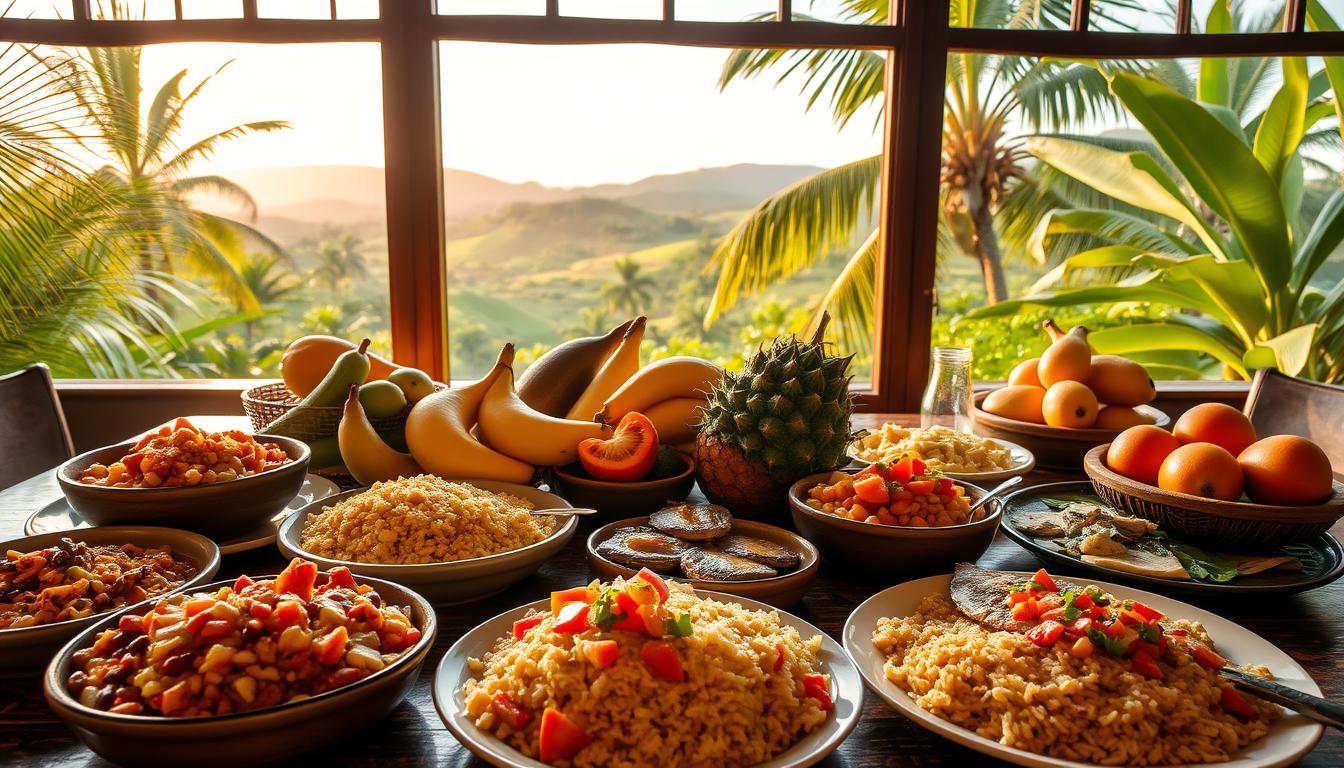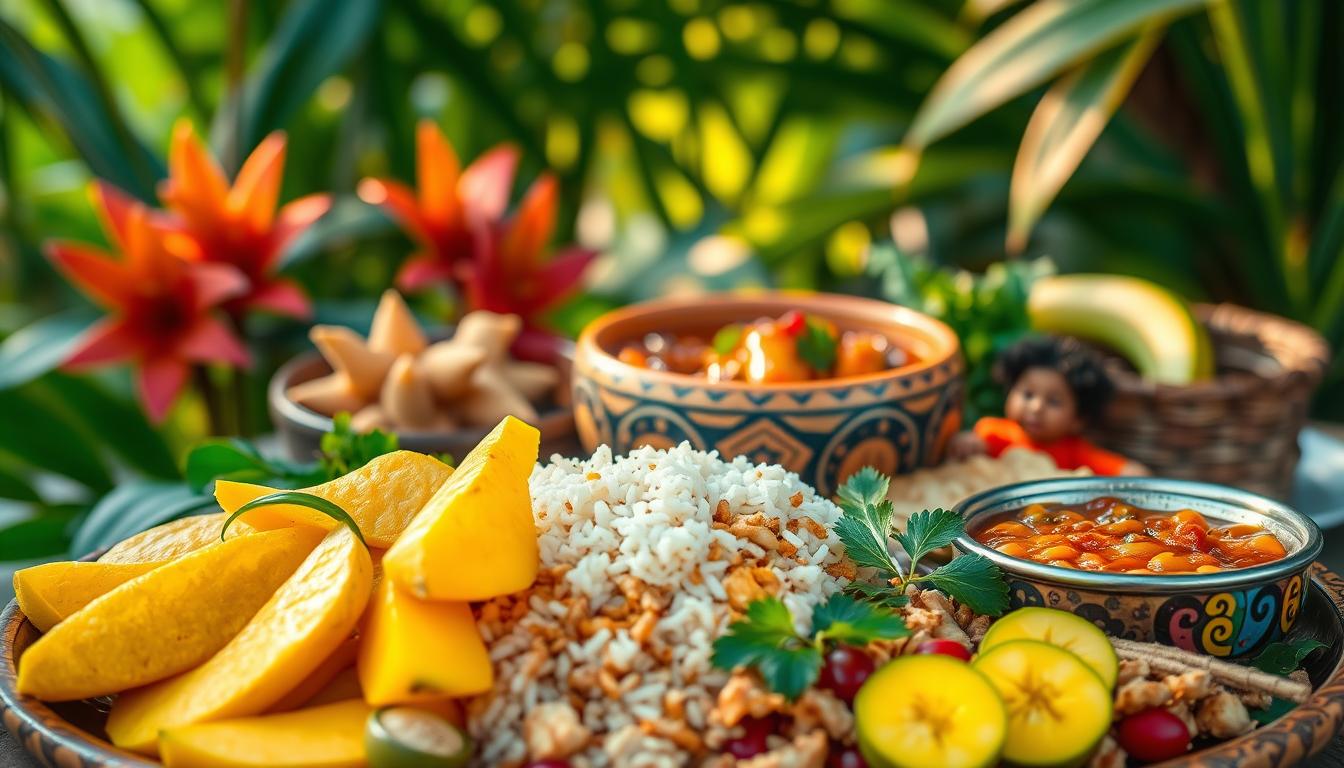Embark on a culinary journey through the heart of Costa Rica, where the vibrant Pura Vida spirit infuses every dish with warmth and flavor. Costa Rican cuisine is a rich tapestry woven from indigenous, Spanish, African, and Caribbean influences, creating a unique gastronomic identity.
This beautiful country is not just about its stunning landscapes; it’s also a paradise for food lovers. From traditional dishes like gallo pinto to fresh seafood and exotic fruits, the flavors of Costa Rica are as diverse as they are delicious.
Key Takeaways
- Discover the essence of Costa Rican cuisine and its cultural significance.
- Explore traditional Costa Rican dishes and their ingredients.
- Learn about the influences that shape Latin American food.
- Understand the role of Pura Vida in Costa Rican culture and cuisine.
- Get insights into the country’s culinary traditions and modern twists.
The Rich Heritage of Costa Rica Culture Food
At the heart of Costa Rican food lies a rich cultural heritage shaped by various influences. The country’s cuisine is a vibrant tapestry woven from threads of history, tradition, and geography.
The Pura Vida Philosophy in Costa Rican Cuisine
The Pura Vida philosophy is more than just a saying in Costa Rica; it’s a way of life that permeates every aspect of the culture, including the cuisine. It translates to “pure life” and embodies a relaxed, nature-loving attitude that is reflected in the simplicity and freshness of Costa Rican dishes. Meals are not just about sustenance but about enjoying time with family and friends, appreciating the beauty of nature, and savoring the flavors of the land.
Indigenous Roots and Spanish Colonial Influences
Costa Rican cuisine has deep indigenous roots, with many traditional dishes tracing back to the pre-Columbian era. The arrival of Spanish colonizers introduced new ingredients and cooking techniques, which blended with the native cuisine to create a unique fusion. This blend is evident in dishes that combine indigenous staples like corn and beans with Spanish-introduced meats and cooking methods.
Agricultural Foundations: From Coffee to Tropical Fruits
The agricultural richness of Costa Rica provides a solid foundation for its cuisine. The country is renowned for its coffee culture, with coffee plantations being a significant part of the agricultural landscape. Additionally, Costa Rica’s tropical climate allows for the cultivation of a wide variety of fruits, from pineapples to mangoes, which are integral to many traditional dishes and desserts. The emphasis on fresh, locally sourced ingredients ensures that Costa Rican cuisine remains vibrant and flavorful.
In conclusion, the rich heritage of Costa Rica’s culture and food is a complex interplay of philosophical outlooks, historical influences, and agricultural abundance. Understanding these elements provides a deeper appreciation for the unique flavors and traditions that define Costa Rican cuisine.
Essential Dishes That Define Costa Rican Cuisine
Costa Rican cuisine is a reflection of the country’s rich cultural heritage. The traditional dishes are simple, yet flavorful, and often feature locally sourced ingredients.
Gallo Pinto: A Breakfast Staple
Gallo Pinto is a staple breakfast dish in Costa Rica, made with fried rice and beans. The name “Gallo Pinto” translates to “spotted rooster,” which refers to the speckled appearance of the dish.
Casado: A Hearty Meal
Casado is a traditional Costa Rican dish that consists of a variety of foods served together on one plate. The dish typically includes rice, beans, meat (usually beef or chicken), and vegetables.
With its rich cultural heritage and love for simple, flavorful food, Costa Rican cuisine has something to offer for everyone.
Regional Culinary Treasures Across Costa Rica
Costa Rica’s diverse geography has given rise to a rich tapestry of regional cuisines, each with its own unique flavors and specialties. As one travels across the country, the distinct culinary identities of different regions become apparent, reflecting the varied cultural and geographical landscapes.

Caribbean Coast: Afro-Caribbean Influences and Coconut-Infused Dishes
The Caribbean coast of Costa Rica is known for its vibrant cultural heritage, which is reflected in its cuisine. Afro-Caribbean influences are evident in dishes that feature coconut milk, such as rice and beans cooked in coconut milk, and various seafood stews. The use of coconut and other local ingredients gives the cuisine of this region a distinct flavor profile. As one local chef aptly put it,
“The secret to our cooking is in the freshness of the ingredients and the love with which we prepare each dish.”
Central Valley: Traditional Hearty Fare and Coffee Culture
The Central Valley is the heartland of Costa Rica, known for its rich agricultural land and traditional cuisine. Hearty dishes such as casado, a plate that includes rice, beans, meat, and vegetables, are staples of the region. The Central Valley is also famous for its coffee culture, with coffee plantations dotting the landscape. Visitors can experience the coffee-making process firsthand at one of the many coffee farms in the area.
Pacific Coast: Seafood Delicacies and Tropical Inspirations
The Pacific coast is renowned for its seafood delicacies, including fresh fish, shrimp, and other seafood. The cuisine here is characterized by its use of tropical ingredients and simple, effective preparation methods that highlight the freshness of the ingredients. Dishes such as ceviche, made with fresh raw fish marinated in lime juice, are popular in this region. The Pacific coast’s culinary scene is also influenced by its tourist industry, with many restaurants offering innovative and fusion dishes.
In conclusion, Costa Rica’s regional cuisines offer a diverse and rich culinary experience. From the Afro-Caribbean flavors of the Caribbean coast to the traditional hearty fare of the Central Valley and the seafood delicacies of the Pacific coast, each region contributes its unique flavors and specialties to the country’s culinary tapestry.
Experiencing Authentic Costa Rican Food Culture
Costa Rica is a country that takes pride in its rich cultural heritage. The country’s cuisine is a reflection of its history, geography, and people. Visitors can experience the authentic Costa Rican culture by trying traditional dishes, visiting local markets, and participating in cultural events.
One of the best ways to experience Costa Rican culture is through its traditional cuisine, such as gallo pinto, a dish made from rice and beans. Visitors can enjoy this dish at local sodas, or small family-owned restaurants.
Costa Rica is famous for its coffee, with regions like Tarrazu and Heredia producing some of the world’s best coffee. Visitors can take a coffee tour to learn about the production process and taste some of the finest coffee in the world.
Family gatherings and celebrations are an integral part of Costa Rican culture. Visitors can experience the warmth and hospitality of the Costa Rican people by participating in these events.
To truly experience Costa Rican culture, visitors should immerse themselves in the local traditions. This can be done by attending a traditional dance performance, taking a cooking class, or simply enjoying a meal with a local family.
Conclusion: Savoring the Spirit of Costa Rica Through Its Food
Costa Rica’s culinary identity is a vibrant reflection of its cultural heritage, blending indigenous, Spanish, and African influences into a unique gastronomic experience. Through its traditional dishes like gallo pinto and ceviche, Costa Rica invites you to explore its rich history and community spirit. Whether you’re savoring local cuisine or experiencing the natural beauty of the country, Costa Rica’s warm and welcoming culture is sure to leave a lasting impression.
Frequently Asked Questions
What is the significance of food in Costa Rican culture?
What are some must-try dishes when visiting Costa Rica?
How does Costa Rican cuisine reflect the country’s cultural heritage?
What is the significance of coffee in Costa Rican culture?
Can I learn about Costa Rican cuisine through cooking classes?
How does the regional diversity of Costa Rica impact its cuisine?



